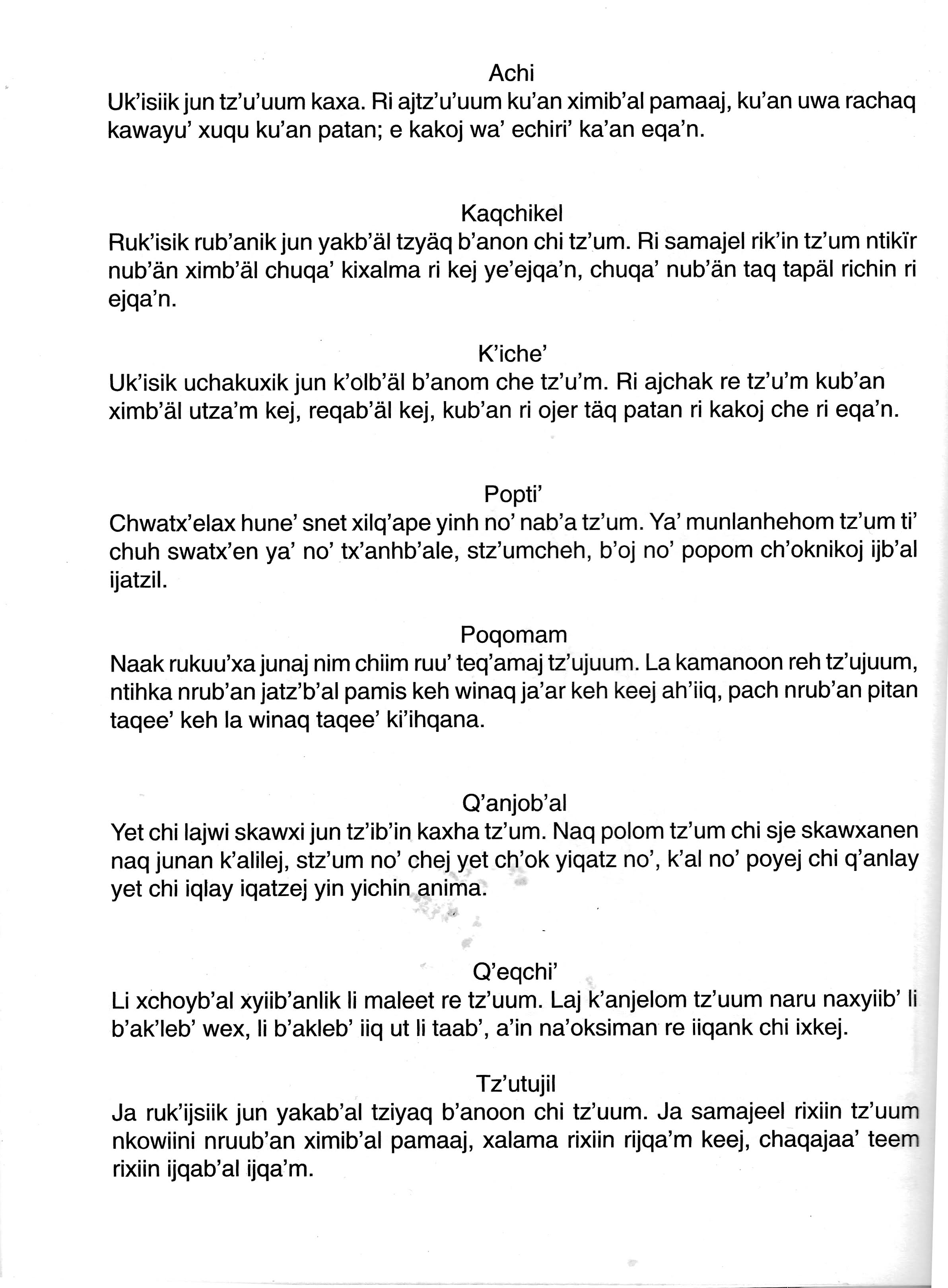New Edition of Artes y Artesanías Mayas de Guatemala/Maya Arts and Crafts of Guatemala Published
Background and New Edition Update along with the Declaration of UNESCO of 2019 as the International Year of Indigenous Languages
A New Edition of Artes y Artesanías Mayas de Guatemala/Maya Arts and Crafts of Guatemala has recently been published by Editiones Del Pensativo (Antigua Guatemala). Events such as this are a world away from the situation suffered by many in 2019 Guatemala, and of course, the tragedy of Guatemalan migrants whose children are separated from them by the Trump administration – along with the plight of countless migrants held in detention or concentration camps. However, my hope is that continuing to support Mayan culture and languages contributes to the people of Guatemala in positive ways, even if it will not impact this crisis.
Background
My devotion to the importance of Mayan languages comes from the experience of living, in the 60s and 70s, in the town of Jacaltenango, where everyone spoke Jacalteco (now called Popti’) Men there were often bilingual, and so also spoke Spanish. Frequently, however, women were monolingual and spoke only Popti’. Countless reasons, globalization, migration and sometimes internal conflicts (such as plagued Guatemala in the 1980s) have caused the twenty two indigenous languages of Guatemala including Popti’, to be spoken less. This results in less social cohesion, with cultural and identity loss. The eight Mayan language/ Spanish/English coloring book Artes Mayas y Artesanías de Guatemala asserts the importance of Mayan languages and encourages pride in speaking and reading them while teaching children about the treasure of the arts and crafts of Guatemala.
My special concern about children in Guatemala dates from the late 1960s when I taught art in schools of Jacaltenango. I fondly remember the creativity of the children and their ability to connect with their culture through drawing. (Even in 2016, in Guatemala for the celebration of the publication of my book Guardians de las artes/Guardians of the Arts, a former student attended my presentation, and reminded me of art projects I had given her and other students!).
Children’s Drawings
Children’s Drawings - Mask
Yet, other kinds of children’s drawings resulted in the 80s when along with their families, thousands of children fled to safety in Mexico, where they were given refuge, to escape army violence in Guatemala. In camps, aid workers encouraged children to make drawings of events that had caused them to leave their homes. Their crayon drawings showed army helicopters and planes bombing, and other kinds of extreme violence.
Years later, in the 1990s, as an artist, it was perhaps logical for me to think of combining my concern for children, my love for the arts and crafts of Guatemala and the indigenous languages in a Mayan languages and Spanish coloring book Artes Mayas y Artesanías of Guatemala.
Original Cover
Mayan Languages
With the help of many, it finally appeared in 2000. After being in print for nearly twenty years, it was gratifying during my visit to Guatemala, in November-December, 2016, to hear Maya educators and colleagues voice their continued support of the coloring book. Others, including librarians, also attested to its usefulness. (Although, at this time, only eight of the twenty one total Mayan languages are included in the coloring book, it is our dream to print another book with eight other major languages.)
New 2019 Edition Update
The New Cover
With pleasure, I can announce that a new edition of the multilingual Artes y Artesanías Mayas de Guatemala/Maya Arts and Crafts of Guatemala (Eight Mayan languages/ Spanish and now including English) coloring book has been printed by Ediciones Del Pensativo (Antigua Guatemala). Preliminary to to this happening, contract negotiations transferred ownership of my publishing rights to Ediciones Del Pensativo. The actual production of the new edition required the input and work of a number of individuals, editor Silvia Pacheco, book and cover designers Hanna Godoy and Myriam Ugarte. Mayan linguists checked the new edition to ensure that with the redesign, no mistakes occurred in the eight Mayan languages captions. (Achi, Kaqchikel, K’che’, Popti’, Poqomam, Q’anjob’al, Q’eqchi’, Tz’utujil).
In 2019, the basic design of the present book looks much like the earlier editions as the same drawings form the body of the book yet there are some significant changes. There is a new cover, and revisions were made to the introduction which gives suggestions for its use by teachers. This was done by one of the long time collaborators, Ajpub' Pablo Ixmata García, of the Universidad Rafael Landívar. As in the past, Maya bilingual schools and educational projects will continue to receive books for their use.
In this new era in the life of the coloring book, enabled by Ediciones Del Pensativo, they now will be able to distribute the book throughout Guatemala which was not possible before. As a publisher and distributor, they have the organization to do that, which we did not have during prior years and earlier printings. We only printed books by soliciting donations from foundations and individuals. They were used mainly in Maya-bilingual schools, but not to sell and distribute throughout the country. (However, in earlier years, we collaborated with the Yax Te’ Foundation Press who did some distribution.) Since 2000, Artes y Artesanías Mayas de Guatemala/(Maya Arts and Crafts of Guatemala) more than 12,000 copies have been printed and distributed. At this time there are no plans to distribute the new edition in the US. A number of the first edition of both multilingual and English/Spanish books are still on hand for interested buyers.
The 2019 Declaration of UNESCO and the Indigenous Commission of Human Rights as the International Year of Indigenous Languages
Another meaning of this new edition relates to the 2019 declaration by UNESCO and the Indigenous Commission of Human Rights as the International Year of Indigenous Languages which has the purpose to educate about and promote the speaking of indigenous languages. In Guatemala, and other countries, there is a new awareness in todays world of the cultural importance of indigenous languages, and also the realization of their fragility.
Everywhere, indigenous languages are being lost. (Every two weeks one disappears.) We are happy that the new edition of Artes y Artesanías Mayas de Guatemala/Maya Arts and Crafts of Guatemala contributes to this world wide effort to promote and conserve indigenous languages.
https://es.unesco.org/news/presentacion-del-ano-internacional-lenguas-indigenas-2019
Acknowledgements:
Many need to be thanked for their help to bring this 2019 book into existence. Beginning in the 1990s, Juan Zapil helped formulate the initial idea for it and I did the drawings. He located and supervised the first translators.
Fernando Peñalosa of the Yax Te’ Foundation, began work in1999, on the initial design, editing and layout. In subsequent years, he continued to supervise re-printings in Guatemala. He deserves special thanks for his many years of effort with the project None of this would have happened without the financial support of The Daniele Agostino Derossi Foundation from the initial printing and including subsequent re-printings. The Puffin Foundation and many individuals, too numerous to mention, must also be thanked.
In 2018-19, Silvia Pacheco of the publisher, Ediciones Del Pensativo spent countless hours attending to the many details required for the production of a new edition. Hanna Godoy was the talented designer while Mimi Ugarte produced a beautiful new cover.






